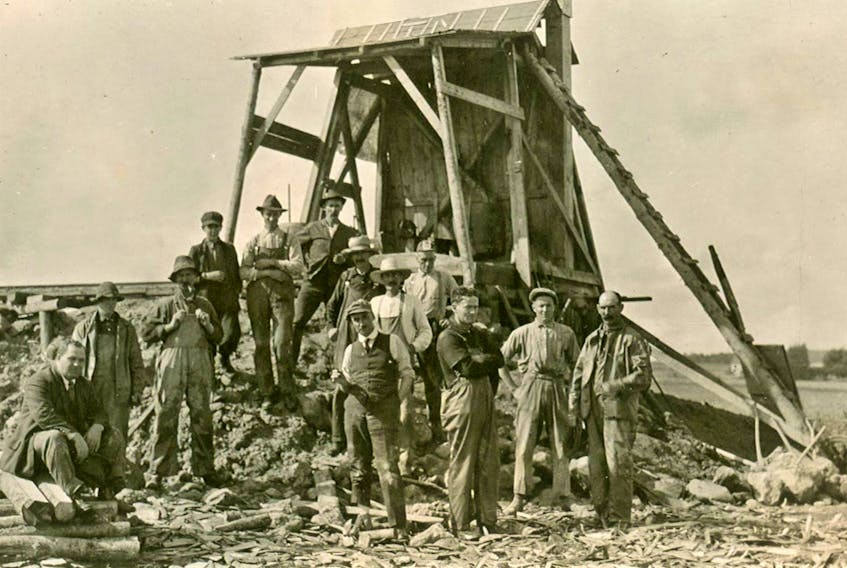History was made when two New Glasgow entrepreneurs opened the first rock salt mine in Canada in 1917.
Allison Robert (Bob) Chambers and George Walker MacKay formed a partnership to develop salt deposits discovered on the North Shore area of Malagash, Cumberland County, Nova Scotia. And it was by pure accident that the brackish substance was discovered, although, well before the European settlers arrived, the Mi’kmaq knew of the salt springs and brine pools of the area.
The commercial development of salt began when Peter Murray, a farmer, owned a parcel of land on the Northumberland sea coast very near the community of Malagash. In 1912, Peter was looking for fresh water for his cattle and he had drilled between several wells on his property and never found fresh water. He did, however, find saltwater. There was said to have been indications of salt before salt licks in the neighbourhood, and many of the other local wells gave a slightly salty water taste.
Just after drilling one of the wells Peter Murray discovered the snow around the well had mysteriously vanished from the barnyard. The water was bubbling out of the ground and he tasted it and almost choked. It was saltier than freshly-salted cod. He gave up his search for fresh water and turned his salt discovery into a business, supplying lumber camps and neighbours with salted pork and pickling brine.
A sample of the salty water was sent to the Department of Mines in Ottawa for analysis. A conclusive report stated: “There was probably a salt deposit of some proportions beneath the Murray property”.
PICTOU COUNTY ENTREPRENEURS

Interest and excitement grew in the region and the two New Glasgow engineers, Bob Chambers and George MacKay paid a visit to the Malagash area to explore potential for future salt mine development.
Both men had extensive experiences in mine and industrial development. George Walker MacKay was the son of Forrest MacKay, who partnered with Graham Fraser to form the Nova Scotia Steel and Coal Company of Trenton, Nova Scotia, where the first successful commercial steel pouring in Canada occurred on July 25, 1883. Young George would complete his education at New Glasgow schools and, following traditions of the day, he completed apprenticeship at the Trenton plant, before going to McGill University where he obtained a civil engineering degree. He practised his profession in Montreal and Northern Ontario and in 1916, returned to New Glasgow, to look after family interests.
Bob Chambers was the son of Robert E. Chambers, the Nova Scotia Steel & Coal Co. mining engineer, who distinguished himself as the founder of the vast ore deposits at the Wabana Iron Mines in Bell Island, N.L. Bob, as a young man, was known to accompany his father on exploratory excursions all over the Maritimes, including iron ore deposits at Bridgeville, Pictou County. As with George MacKay, Bob Chambers would obtain his early schooling in New Glasgow and then obtained a Bachelor of Science (mining) degree. Bob would go on to manage the Ore Mines and quarries in Newfoundland and Nova Scotia until 1917.
Thus, in 1917, the two New Glasgow men, George W. MacKay and A. Bob Chambers formed a partnership called Chambers-Mackay Salt Company Limited. The partners acted quickly and leased land from the owners in the district, including Murray. A diamond drill was brought to the Murray property and the “outcome was that steeply standing salt beds were encountered at a very shallow depth, 85 feet, and on Dominion Day 1918, five men and a horse commenced shaft sinking and a first tub of rock salt seen in Canada was hoisted on Labour Day, 1918....” making the Malagash site “the first rock salt mine” in Canada. The company was soon producing 30 to 40 tons of salt per day. Horse-drawn wagons freighted the salt to the nearest rail point, eight miles away. In 1918 the Department of Mines in Ottawa reported that this discovery in Malagash, “is important to Canada and more especially to the Maritime provinces. Considerable amounts would be for domestic purposes in the Maritimes and by developing foreign markets.”
For the next seven years the partners persevered at the Malagash site, production continued to grow, and new buildings were erected. Tragedy would strike on July 28, 1923 when the entire first mill was destroyed by fire. Undaunted, a new mill was erected quickly; the Chambers & MacKay partnership dissolved as such and Malagash Salt Products Limited formed. In 1927 it was reorganized again to create Malagash Salt Company Limited, with head office at 196 Provost St. in New Glasgow. The operation lasted 41 years until 1959, when the Pugwash Salt mine opened.
Chambers had the ideas, the courage and the know-how to begin the industry and George W. MacKay had the money. He had the money and was willing to gamble on a Nova Scotia industry. Few Nova Scotians have been so inclined, preferring always to invest in areas remote from Eastern Canada. In an interview in 1972, George W. MacKay stated, "We never made any money until we got into the highway salt business." Just 14 days after the interview in 1972, George Walker MacKay passed away at the age 91.
THE INVENTOR

Bob Chambers, the engineer, had many ideas; certainly, numerous inventions were registered with the Canadian Patents Office in Ottawa. One discovery that did change the road building business was the finding of “salt soil concrete.” In the late 1920s highway engineers were seeking a cheap means of prolonging the surface of dirt roads, which were beginning to suffer the ravages of heavy motor traffic. Chambers discovered that rock salt mixed with clay presented a tough surface to both weather and traffic, and so took out a patent on the process. He knew for many years the ceramics industry had made use of common salt to improve the drying properties of clay. Chambers had researched and studied the process and determined that “no effort had been made to apply the chemical reaction between salt and clay.” Experimenting with the mixture he suggested it be applied on some Nova Scotia dirt roads.
In 1927 and 1928, Chambers, with permission from the Nova Scotia Department of Highways, constructed short stretches of highway near Truro and Elmsdale which proved to his own satisfaction that the application of salt did much to improve the dust problem. This discovery caught the attention of United States highway experts.
Chambers's idea was taken back to the Unites States, where they further experimented with the process. The result was the development of an entirely new highway surface known as “soil concrete.” Each year more and more salt was sold for highway use as a dust layer and a form of a primitive type of hard surfacing. However, the advent of paved roads and the economic depression of the 1930s brought the Malagash Salt Company into a scary financial position. Chambers would never see the firm’s remarkable turnaround; he died in Montreal on Dec. 4, 1937 at the age of 57.
MacKay continued the Malagash operations with several new mine managers over the next 13 years, including New Glasgow-born Dr. John L. Cavanaugh, who was credited with keeping the salt industry at Malagash alive.
In 1951 the Canadian Salt Company bought all of the Malagash company's stock and began to operate it as its subsidiary. By 1956, due to transportation and operating difficulties, the Malagash mine was no longer economical to operate. A better harbour and rail spur existed at Pugwash, where a new shaft was sunk. In 1959 the company transferred its operations there and became known as the Canadian Salt Company.
Interesting to note, the Malagash Salt Mines Museum. located at 1926 North Shore Road, Malagash has hundreds of artifacts related to the salt mine and community.
John Ashton is a historical author, and graphic and visual artist and operates a 34-year Nova Scotia-registered business, Ashton Creative Design in Bridgeville, Pictou County. He may be reached at [email protected]









